**Jenny not Kenny 🫣
29.08.2025 14:54 — 👍 0 🔁 0 💬 0 📌 0Macla Ramirez-Tannus
@maclart.bsky.social
Colombian | Astronomer working massive star and planet formation in eXtreme UV Environments.
@maclart.bsky.social
Colombian | Astronomer working massive star and planet formation in eXtreme UV Environments.
**Jenny not Kenny 🫣
29.08.2025 14:54 — 👍 0 🔁 0 💬 0 📌 0Check out the last press release of the #XUE collaboration. Very proud of our PhD student Kenny for all the work she put in to get those nice results!
29.08.2025 11:46 — 👍 7 🔁 0 💬 1 📌 0Jorge!! Suena increíble 🤩 felicitaciones! #CERN tiene suerte de tenerte en su equipo!
29.01.2025 15:04 — 👍 3 🔁 0 💬 1 📌 0🙋
17.01.2025 15:55 — 👍 0 🔁 0 💬 0 📌 0🤩🤩🤩
18.12.2024 07:54 — 👍 3 🔁 0 💬 0 📌 0
Applications are open for the 2025 MPIA Summer Internship for bachelor and master students! 🔭
Deadline: 15 January 2025
More details: www.mpia.de/en/careers/i...

Ankündigung der Online-Talkrunde zum Thema "Planetenentstehung unter härtesten Bedingungen" mit Carolin Liefke, Markus Pössel und María Claudia Ramírez-Tannus am 22. Januar 2024 um 19 Uhr live auf der Facebook-Seite und auf dem Youtube-Kanal des Hauses der Astronomie mit einer künstlerischen Darstellung einer protoplanetaren Scheibe in einem Nebel. In der Ferne ein Stern, der eine leere Blase um sich gebildet hat
Können Planeten auch in Sternentstehungsregionen entstehen, die vom energiereichen UV-Licht massereicher Sterne durchflutet werden? @mpoessel.de und @astrophysikerin.bsky.social fragen heute Abend bei Astro & Co @maclart.bsky.social vom @mpi-astro.bsky.social
www.youtube.com/watch?v=rOaB...
Congrats! I wish you all the best 🥰
13.01.2024 22:12 — 👍 1 🔁 0 💬 1 📌 0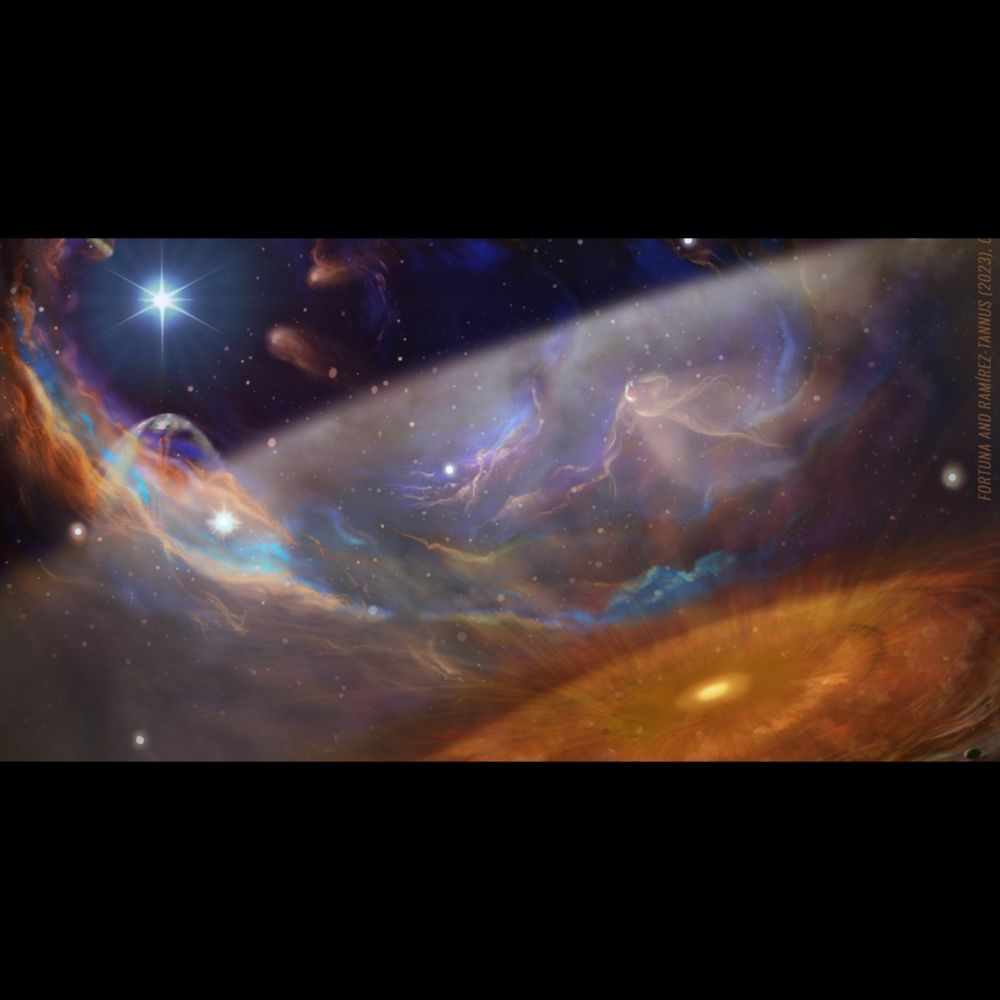
Strong UV radiation? Doesn't matter, water and organic molecules still form in protoplanetary discs, as @maclart.bsky.social from MPIA and her team have found out with JWST
www.mpia.de/news/science...

Starke UV-Strahlung? Egal, Wasser und organische Moleküle bilden sich trotzdem in protoplanetaren Scheiben, wie María Claudia Ramírez-Tannus vom MPIA und ihr Team mit dem JWST herausgefunden haben
www.mpia.de/aktuelles/wi...
Thanks 🙂! Do you mean at 7.5 micron? Those two are Hydrogen lines from the Pfund and Humphreys series.
30.11.2023 10:57 — 👍 1 🔁 0 💬 0 📌 0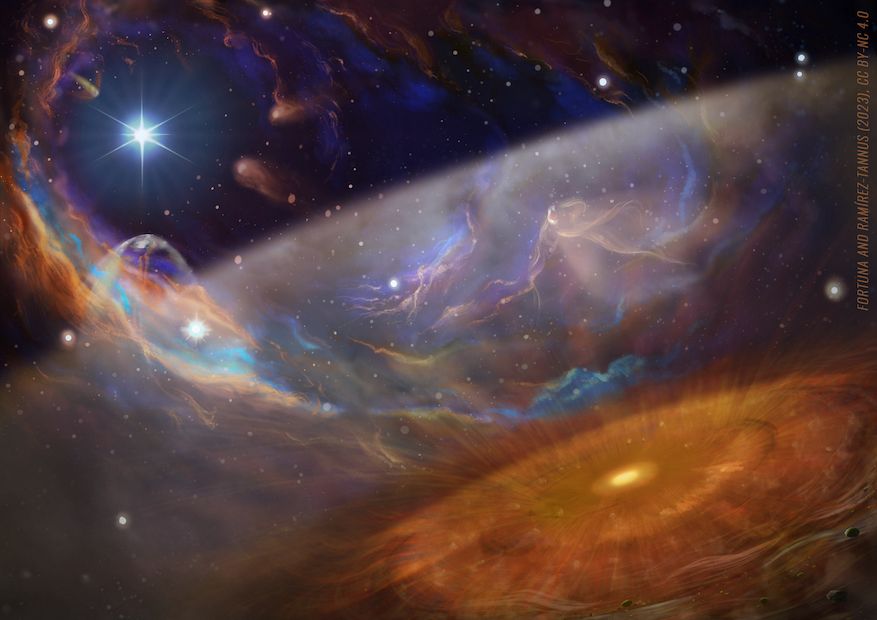
Aardachtige planeten kunnen zelfs ontstaan onder barre omstandigheden
www.astronomie.nl/nieuws/aarda...
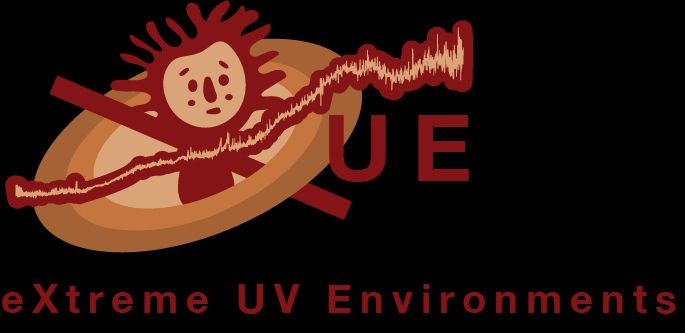
This is our logo! It shows Xué, the god of the Sun in the Muisca culture, surrounded by a proto-planetary disk. One of its arms is the actual #JWST MIRI spectrum of XUE1! Thanks to Maria Cristina Fortuna for the logo and the beautiful illustration!
30.11.2023 09:32 — 👍 1 🔁 0 💬 0 📌 0We are now analysing the rest of our observations in order to understand how common is XUE1 It is a very exciting time to be an astronomer! You can read the paper here:
iopscience.iop.org/article/10.3...
XUE stands for eXtreme UV Environments and the collaboration is formed by more than 30 scientists around the world. Xue is also the name of the god of the Sun in the Muisca culture 🇨🇴🌞!
30.11.2023 09:24 — 👍 0 🔁 0 💬 1 📌 0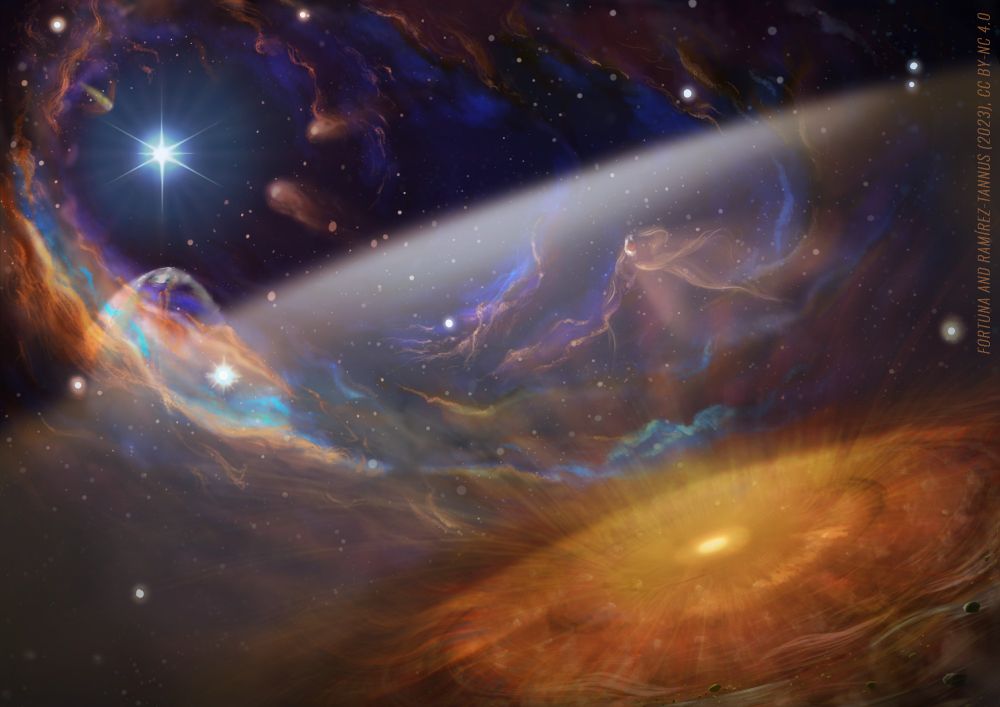
Illustration of XUE1, a highly irradiated disk where we find water, CO and other molecules that are the building blocks of planets.
We report on the discovery of water and other molecules in the terrestrial forming zone of XUE1, near one of the most massive stars in the Galaxy! We show that there are favourable conditions to form Earth-like planets and the ingredients for life even in the harshest environments in our Galaxy 🔭🌌!
30.11.2023 09:04 — 👍 7 🔁 0 💬 1 📌 0A couple of weeks ago the first paper of the XUE collaboration was accepted 🔭. We are studying the properties of disks in extreme UV radiation environments and trying to figure out what massive stars do to the forming sites of Earth-like planets.
www.mpia.de/news/science...
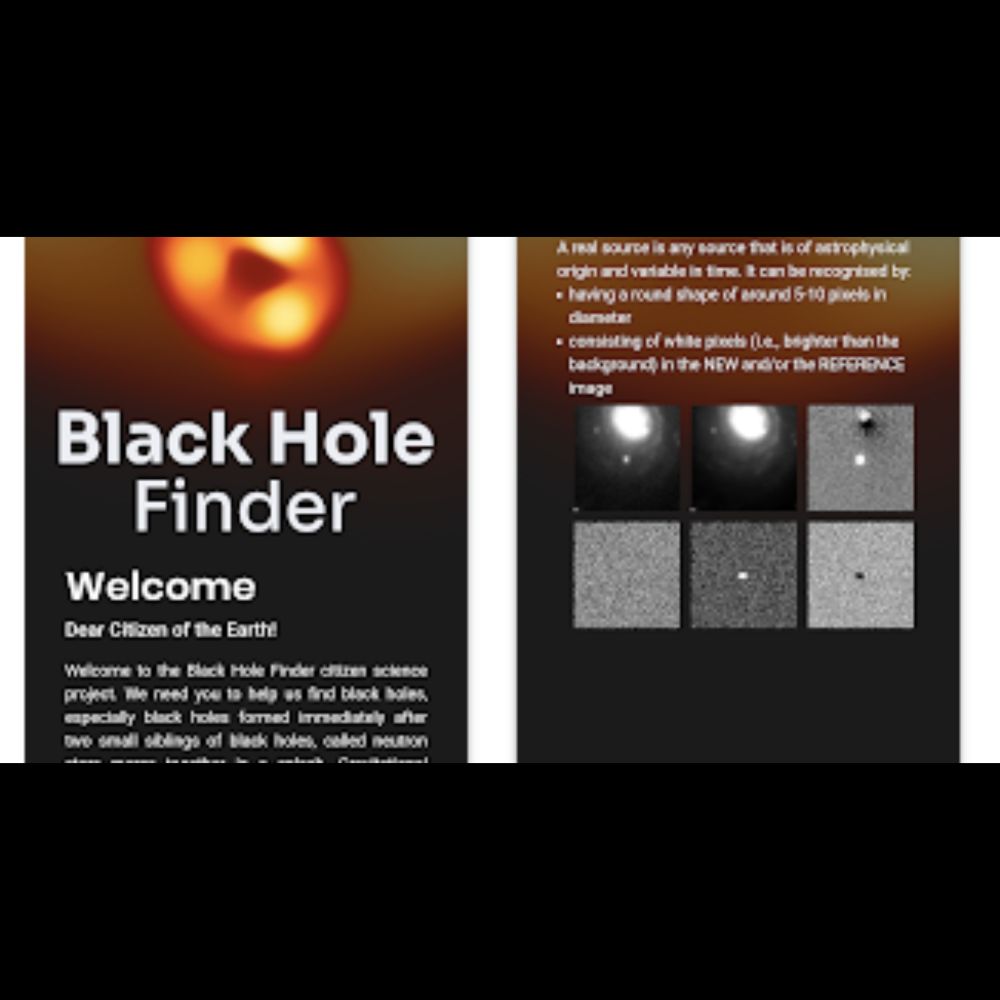
Citizen scientists 🧪🔭 Please help us find new black holes with this amazing new app! Download to help identify new transients and to train our system. You will be a coauthor, and top classifiers will even be able to trigger follow up observations with real telescopes!
www.dbhc.nl/news/black-h...
Qué bueno, Jorge!! Me alegra por ti 😊
25.10.2023 21:16 — 👍 1 🔁 0 💬 1 📌 0I agree! it was the nicest it could have been for the last day before the JWST deadline 😊
25.10.2023 20:57 — 👍 1 🔁 0 💬 0 📌 0I was! Most of the day making Newton disks with our younger visitors 🌈 🔭. I hope you enjoyed your day 🙂
14.10.2023 18:34 — 👍 2 🔁 0 💬 1 📌 0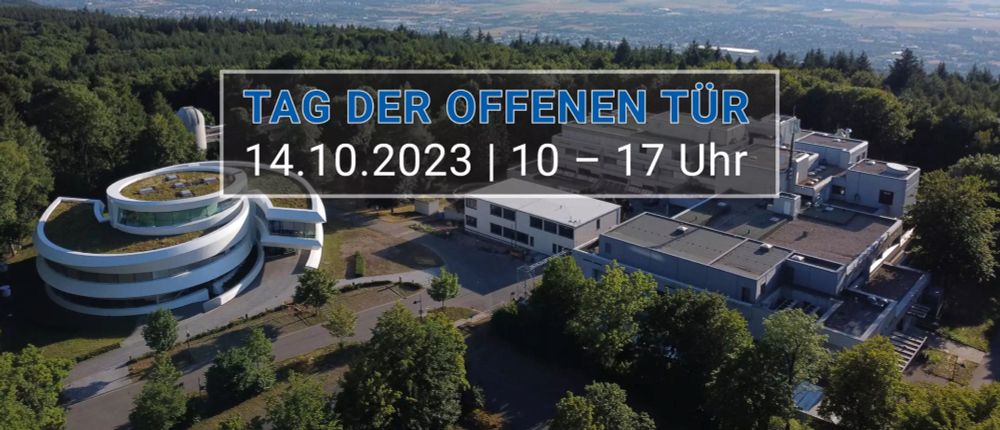
Überblick des MPIA-Campus mit Beschriftung "Tag der Offenen Tür, 14.10.2023, 10 bis 17 Uhr"
Am kommenden Samstag ist es soweit – dann gehen bei uns eine ganze Menge Türen auf. Wer in der Gegend ist: schaut doch mal vorbei, bei unserem Tag der Offenen Tür! 14. Oktober von 10 bis 17 Uhr. Es gibt viel zu sehen, zu hören und zu machen – z.B. auch für Kinder! www.mpia.de/tdot2023
10.10.2023 21:21 — 👍 15 🔁 9 💬 0 📌 1This is the fourth of a series of papers about the very interesting *Massive pre-main sequence stars in M17*:
1st arxiv.org/pdf/1704.082...
2nd: arxiv.org/pdf/2301.068...
3rd: arxiv.org/pdf/2305.014...
This is a great step to start linking variability to physical precesses in the disk, but we need more data of a larger sample in order to understand the big picture 🤓
09.10.2023 12:30 — 👍 0 🔁 0 💬 1 📌 0In general, we find that even if these objects are very close to each other in the HRD, they have VERY different variability properties. Meaning that it is complicated ! There are probably several physical processes happening at the same time.
09.10.2023 12:30 — 👍 0 🔁 0 💬 1 📌 0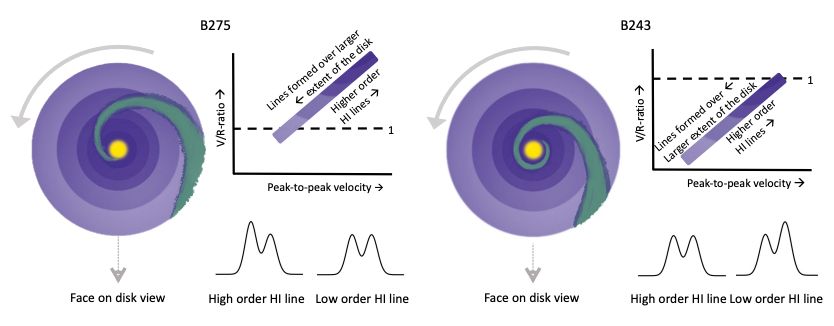
Sketch of two of the disks in our sample. The positive trend between V/R-ratio and peak-to-peak velocity might be explained by spiral arms.
A very cool thing is that the enormous wavelength range of X-shooter allows us to study several lines of the same series. Annelotte finds that for a given epoch, the differences observed amongst the lines could point to spiral structures
09.10.2023 12:29 — 👍 0 🔁 0 💬 1 📌 0In several of the PMS stars, we identify many disk features, including a new detection of CO bandheads and CI emission! In three of them we detect significant variability in a velocity range up to 320 km/s!
09.10.2023 12:28 — 👍 0 🔁 0 💬 1 📌 0🚨Paper alert!! 🔭🚨
This is the first first author paper of A. Derkink from API in Amsterdam. We present a study of the spectroscopic variability of massive pre-main sequence stars in order to learn about the physical processes happening in their disks...
arxiv.org/pdf/2310.042...
👋 Hola!! I'm new 🙃... I'm a Colombian astronomer 🇨🇴 now a postdoc fellow at MPIA 🔭 in Heidelberg 🇩🇪. I study young massive stars and planet formation in extreme radiation environments 🌌. I'm the PI of the XUE collaboration 🌞 and the mom of a two year old.
04.10.2023 20:51 — 👍 9 🔁 0 💬 1 📌 0